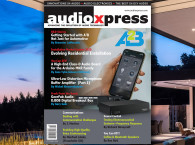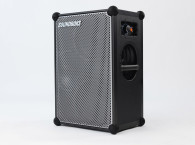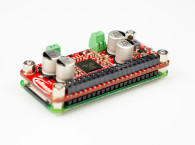Since 2005, Arduino boards have been steadily growing in popularity among makers and DIY enthusiasts, who have developed a broad variety of projects—ranging from gaming consoles and drone controls to various smart-home automation projects. Arduino boards are based on the open-source hard- and software, licensed under the GNU Lesser General Public License (LGPL) or the GNU General Public License (GPL), enabling board manufacturing and software distribution by anyone. This extends the development of high-performance embedded computing power to a much wider audience — including people without a professional hardware or software background.
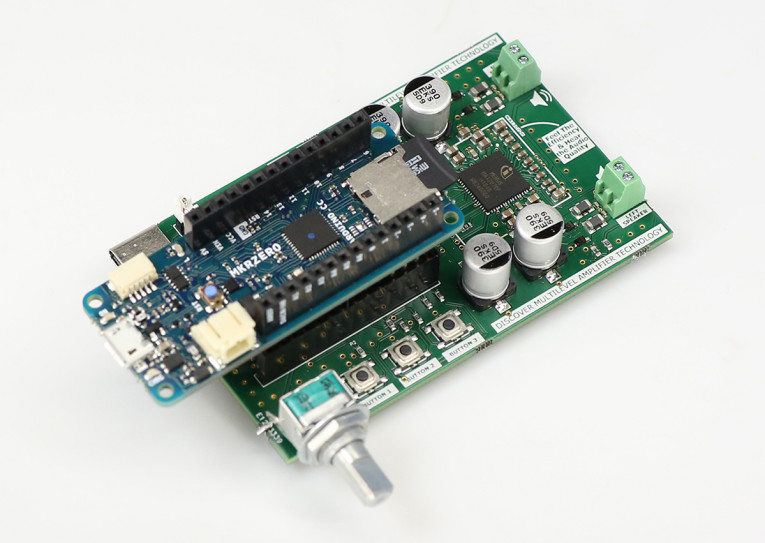
When looking at the different types of DIY projects, it is interesting to see that many revolve around audio applications and connectivity (e.g., IoT audio interaction or stand-alone audio players). However, until recently, it was necessary to add several separate boards or “shields” together to realize such a system. This has changed since the release of the MKR family, where Arduino has now added audio features such as an I2S bus, SD card audio read/write, and Alexa voice-control compatibility.
This also makes the Arduino platform a perfect demonstration vehicle for Infineon’s high-performance integrated MERUS multilevel Class-D audio ICs. By releasing a fully compatible and power-efficient amplifier board with enough output power to drive a variety of speakers—all with best-in-class audio performance, low power consumption and high efficiency—Infineon is providing yet another useful building block to the Arduino ecosystem.
Key parameters and features of the new Infineon Arduino board KIT_ARDMKR_AMP_40W (compatible with Arduino MKRZERO and MKR1000 Wi-Fi) include an integrated MERUS MA12070P proprietary multilevel Class-D audio amplifier; 5 V/2.5 A power input, sourced from the same single USB-C power supply or battery pack, and delivering up to 40 W instantaneous peak output power with those supplies. No need for external or extra power supplies.
With this board, Arduino fans around the world are now able to build their own high-end wireless audio players, with full hardware control, customization, and error monitoring possible through the Arduino programming framework. And thanks to the recent addition of Arduino’s Amazon Alexa skill, it is even possible to connect Alexa to Arduino IoT cloud projects, without the need for additional coding.
Cool Technology Optimized for Music Playback
The KIT_ARDMKR_AMP_40W is an audio amplifier board, compatible with the MKRZERO board from Arduino, and built around Infineon’s MERUS MA12070P multilevel amplifier. Photo 1 depicts, how Arduino’s MKRZERO fits on top of the KIT_ARDMKR_AMP_40W, which has been designed to offer excellent audio quality and easy compatibility with the Arduino MKRZERO boards. More specifically, the boards cater to applications such as portable speakers, smart speakers, DIY hi-fi speakers, or any kind of consumer-oriented audio prototyping.
Infineon’s MERUS MA12070P multilevel amplifier is optimized to effectively reproduce the dynamics of music signals. While operating extremely efficiently at low to moderate output power levels, it can deliver very high peak output power levels during highly dynamic music passages — all in a small form factor with minimum power loss and no need for bulky heatsinks.
Just by touching the amplifier during operation, its efficiency is noticeable. Even when it is playing at high volumes, the IC stays completely cool as almost all of the energy delivered from the power supply is passed on to the speaker.
Figure 1 provides a more detailed system overview. The system’s power section is designed to alleviate common challenges associated with the audio design (i.e., providing enough continuous power in combination with peak output power and sufficient voltage headroom to allow undistorted music playback).
To this end, the board incorporates a boost converter that boosts the voltage from a simple USB-C input power adapter or a battery from 5V to 20V. The boosted 20V is used as the power supply for the power amplifier section, while the bulk capacitance stores peak energy for the short-burst peak power delivery.
MERUS MA12070P is by default configured to drive two speakers (BTL), but can also be configured as one single, more powerful channel (PBTL). The power section with its amplifier can deliver up to 20W instantaneous peak power per channel (40W total). Nominal speaker impedance can typically vary from 4Ω to 8Ω. Under specific conditions, lower or higher impedances are possible too. The used amplifier IC has a digital front end, including volume control and limiter functionality. On top of that, the amplifier configuration has (status) registers that can be accessed by using the I2C communication protocol.

System Overview
The main processor unit in the system is the Arduino MKRZERO (or a similar board from the same family). This microcontroller board can stream I2S audio while at the same time taking care of housekeeping functions, such as amplifier register configuration over I2C and interrupt-based status monitoring. Besides that, by using the ADC and GPIOs, some user-interface functions (e.g., volume control, generic push-buttons, and LEDs) have been implemented.
Debunking the Output-Power Myth
A common misunderstanding in the world of audio engineering, especially when it comes to specifying amplifiers, is that they require a lot of output power (i.e., that at least hundreds of watts and preferably more is necessary to have an immersive and engaging hi-fi sound experience).
Although this may be true for some applications, it is definitely not true for most applications in the consumer audio space. Unfortunately, many audiophiles (and even a few professional audio engineers and marketers) wrongly equate output power to loudness. However, loudness is not measured in watts.
Quoting a certain output power without further information is a bit like saying that a specific town you want to visit is an hour away. Unless you also provide information about under which conditions (i.e., if you mean one hour of walking, riding a bicycle, or by a car while observing the speed limits), this information is useless. Although there is a correlation between the amplifier output power and loudness, the actual speaker(s) in the audio system play(s) a far more important role when it comes to loudness.
A very important parameter, therefore, is the speaker’s sensitivity, which determines the amount of power that is necessary to drive a certain loudspeaker to a certain loudness. More specifically, it measures the sound pressure level (SPL), typically expressed in decibels (dB), which will be derived from the speaker with 1 W of power input (or 2.83 V sinus input across an 8 Ω speaker), measured at a 1-meter distance.
Bookshelf speakers typically have sensitivity values of 85 dB to 89 dB, whereas floor-standing models typically range from 87 dB to 92 dB. High-efficiency speakers are in the 93 dB to 100+ dB range and pro equipment (e.g., horn speakers) can have sensitivities as high as 111 dB.
Also, the number of speakers is an important parameter. When using two speakers instead of one at the same distance and with the same sensitivity, 3 dB of SPL are added at the listening position. Similarly, the placement of the speakers also plays a key role. So-called “room gain” means that the sound reflected from the walls can reinforce the sound that is coming directly from the speakers.
Placing the speaker near a wall adds around 3 dB SPL at the listening position. This effect is most prominent at low (bass) frequencies and explains why subwoofers often sound louder when placed near a wall, or ideally in a corner.
The distance from a listener to the speaker and the dispersion play a critical role in the loudness at the listener’s position. Therefore, please consider the data in Figure 2, showing how much loudness can be produced based on a single speaker with a modest sensitivity of 86 dB (for two speakers simply add 3 dB and another 3 dB if the speakers are placed near a wall).
Note that even very low output-power levels (from 0.0001 W to 0.1 W) will produce loudness levels comparable to that of speech or a vacuum cleaner and that the typical average output power levels for most standard-sized living-room music playback situations are not more than a couple of watts.
For every 3dB increase of loudness, a duplication of the amplifier’s output power is needed. The output power number starts to rapidly escalate when loudness levels equivalent to nightclubs and live rock concerts are reached. Those, however, are not the target applications for the Arduino board.
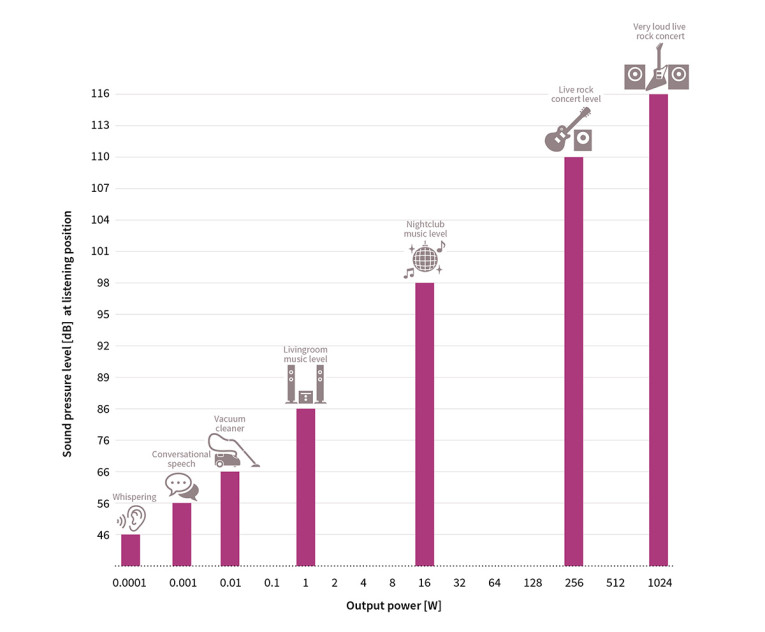
How Loud Is Loud Enough?
How much loudness do people actually need? How much will they tolerate inside the living room when listening to music? Does this Arduino board fit the bill? With the Arduino board, approximately 20 W instantaneous peak and maximum 5 W continuous (RMS) power per channel can be reached. Given two free-standing speakers with a modest 86 dB sensitivity, this corresponds to 102 dB peak and 96 dB average SPL, respectively, at a 1-meter distance. In a typical living room with a 3-meter distance to speakers near a wall, the maximum SPL values of 95.5 dB peak and 89.5 dB average, respectively, can be reached.
Is This Loud Enough?
As a reference, a few years back Stereophile magazine did a study and discovered that the average listening level in most of the rooms of the audiophiles that they surveyed was around 83 dB SPL. As it turns out, above this level people are not just listening to the sound from the speakers but increasingly to the sound of the room (meaning that reflections and reverberations from the wall floor and ceiling dramatically change the frequency response of the music being played). Hence above this level (potential longer-term hearing loss aside), it is advisable to consider some form of room treatment to make sure that the room is matched to the listening volume level.
According to Audio Engineering Society (AES) Fellow Floyd E. Toole [1], professional installers of high-end home cinema sound systems report that their customers typically play movies at -10 dB or lower. That is a power reduction of a factor of 10, which is a significant cost factor when equipping a theater but also a considerable price difference for home audio equipment. As seen in the previous example, even a reduction of 3 dB is a factor of two in power. Hence, the obsession with output power may not only be misleading, it can also unnecessarily empty a wallet.
The best way to find out how much SPL is enough is to take a phone and download a sound pressure app. There are plenty of smartphone apps on the market, which allow for taking measurements on the pressure in a room. By doing some readings while playing the music in a typical daily situation, the average listening level can be discovered and then compared to the above information. It is surprising, how low a normal SPL listening level is, and even more surprising is the calculated corresponding power requirement based on the speaker’s sensitivity.
If the Arduino amplifier is powerful enough for the targeted application, this compact multilevel Class-D audio amplifier design example should bring awesome sound qualities to the audio listening experience. aX
This article was originally published in audioXpress, October 2020
References
[1] F. E. Toole, Sound Reproduction: The Acoustics and Pyschoacoustics of Loudspeakers and Rooms, Third Edition, Routledge; July 2017, pp. 48.
Resources
Infineon KIT_ARDMKR_AMP_40W
“Design of an Arduino Compatible Audio Amplifier Platform,” Application note for KIT_ARDMKR_AMP_40W, Infineon
www.infineon.com/dgdl/Infineon-Evaluation_kit_KIT_ARDMKR_AMP_40W-ApplicationNotes-v01_00-EN.pdf

What Is a Conventional Class-D Amplifier?
A Class-D amplifier, also called a switching amplifier, is an electronic amplifier in which the transistors operate as electronic switches and not as linear gain devices as in other amplifiers (e.g., Class A or Class A/B). Instead, they operate by rapidly switching the output back and forth between the supply rails, being fed by a modulator using pulse width, pulse density, or related techniques to encode the audio input into a pulse train. The train of pulses is subsequently applied to the loudspeaker—often through a low-pass filter to block high-frequency components of the transients. Since the pairs of output transistors in the output stage are never conducting at the same time, there is no other path for current to flow apart from the low-pass filter and the loudspeaker. For this reason, the efficiency of a Class-D amplifier can exceed 90% at full output meaning that only 10% of the applied energy from the power supply is lost as heat and 90% is used to move the speaker coil and produce sound.
What Is a Multilevel Class-D Amplifier?
In a conventional Class-D amplifier, there is a lot of switching activity—even in an idle and near-idle mode, meaning when there is a silent passage in the music. Each transistor pair in the (half-bridge) output stage changes the duty cycle to create the desired output level. However, even if no output and no sound is coming from the speakers, there is a lot of internal switching activity going on, which entails switching loss. Hence, conventional Class-D amplifiers are not very efficient at idle power, which dominates the average power level for music signals and has many passages of relatively low signals as well as many signal peaks.
This is visible in Figure 3 as the shaded area in the curve. In contrast, due to proprietary and patented circuit architecture, the multilevel amplifier’s eight smaller MOSFETs can scale the output to a much higher granularity in terms of resulting switching frequency and output levels. Essentially, this dramatically reduces power losses, provides much higher output signal granularity, and yields many other additional benefits such as less out-of-band noise, higher tolerance for power supply ripples, less need for bulky output filtering components, and so forth.

About the Author
After the Infineon acquisition of Class-D Amplifier IC startup Merus Audio, where Jens Tybo Jensen was serving as VP Sales and Marketing, Jensen became head of Marketing & Application Engineering for all Class-D Audio Products within Infineon Technologies. Prior to his tenure with Merus Audio, Jensen held a European Sales Director position with Knowles Electronics — a global supplier of high-performance micro-acoustic components and intelligent audio IC solutions. His global business development experience stems from a variety of start-ups and international hi-tech companies. Jensen was co-founder and VP Sales at Nangate, Inc., which was acquired by Silvaco, Inc. He also served as VP Sales & Marketing for Exbit Technology A/S, which is now a part of Microsemi Corp. Jensen holds a B.Sc.EE degree from the Technical University of Denmark and an Executive MBA from Copenhagen Business School.



